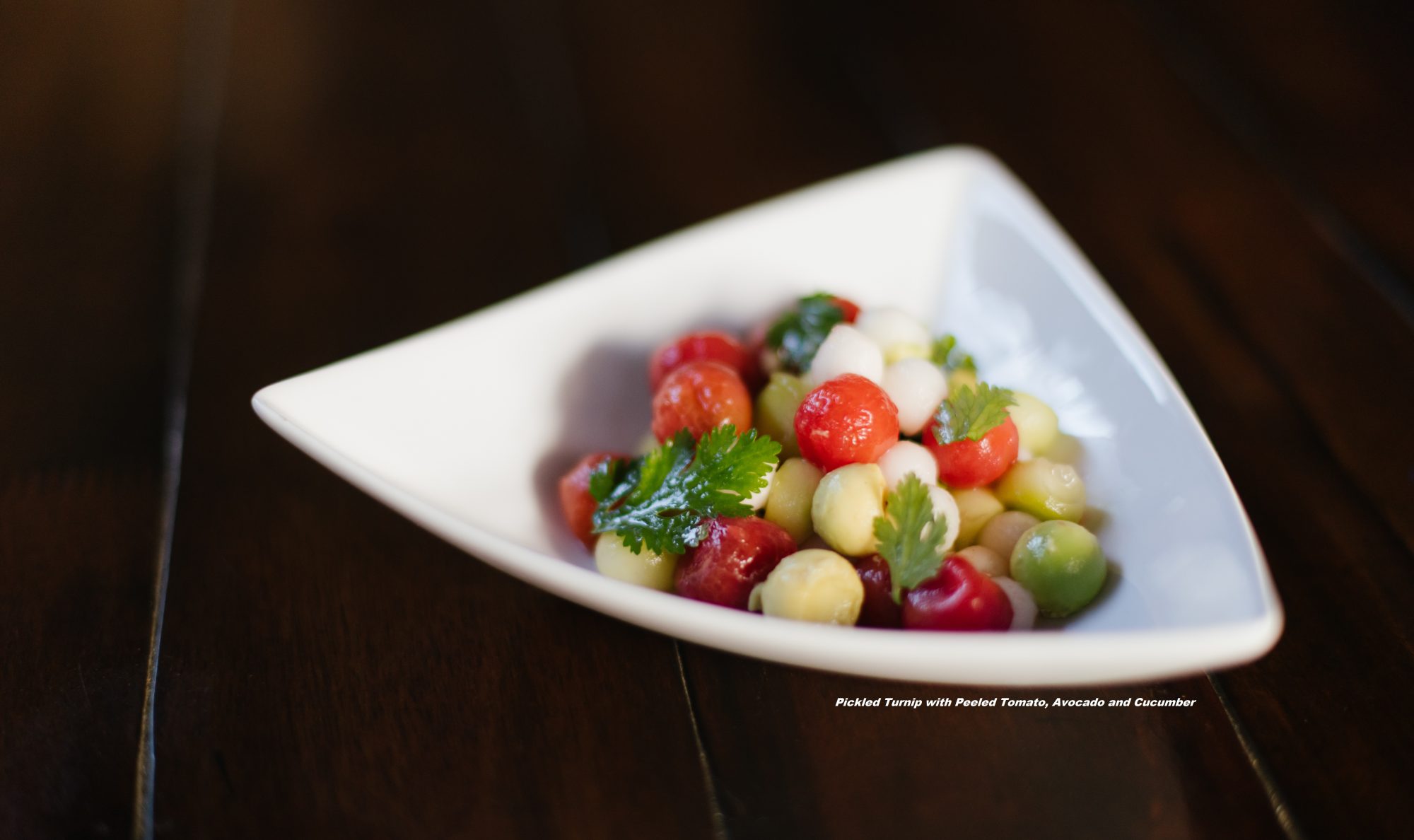As stated before, I’m a personal chef. That means I’ve seen countless home kitchens, from mind blowing on every level, to, “oh my god, this isn’t even a kitchen, and why is the water brown.”
It was hard not to notice how many people had the same horrible teflon pans, plastic spatulas and micro serrated knives.
Here, in no particular order are 10 kitchen tools I deem essential for producing a wide variety of quality, consistent meals. I didn’t say hand tools, just the basic essentials for in home gourmet cuisine. (This might seem long, but it’s a quick read)
1. Good knife and steel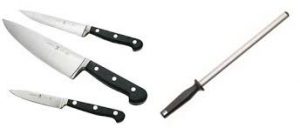
I know, I know; everyone always says, get a good knife. But it’s true; a decent, sharp knife is the most essential tool in the kitchen. Don’t let anyone tell you, you NEED that $150 chefs knife. I’ve seen men do amazing things with the cheapest knives in the world…so why does everyone think they need a Global or Wusthof to cook proper food? Learn to sharpen a knife properly and the world is your oyster. Whether with a sharpening stone, ceramic rods, or a mechanized apparatus; learn to sharpen and you’ll be happy with a $20 knife.
Not to say that the expensive ones aren’t better, but dropping a ton of dough on a knife when you can’t even keep it sharp doesn’t make sense. Plus, you’ll want to use your less expensive models for honing your technique. This is where the steel comes in handy. It is important to keep in mind that with knifes there is going to be injuries, First Aid Training can help you manage any injuries with minimal pain. A steel is the long metal rod you see people “sharpening” their knives on before use. Although there is the appearance of sharpening; the steel is cleaning and straightening the knife, as opposed to actually creating a fresh new edge.
In the event your ready to burn some cash; stick with a model that is comfortable in your hand, heavy for its size, has smooth top edges and is pleasing to to look at. Always feel and hold knives before you purchase them. Go to a knife shop and talk to the salesman about comparisons.
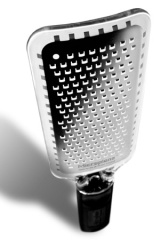 Another route is ceramic knives, mainly from Kyocera. They’ll definitely scorch your pocketbook, but, for the home or hobby chef, they’re fantastic. They stay sharp for a very long time and after a year or two, you mail it back to the company with $10; and they ship it back in a few days with a brand new edge. They are very brittle so you can’t smash garlic or peel a watermelon; but for small jobs, they’re just great.
Another route is ceramic knives, mainly from Kyocera. They’ll definitely scorch your pocketbook, but, for the home or hobby chef, they’re fantastic. They stay sharp for a very long time and after a year or two, you mail it back to the company with $10; and they ship it back in a few days with a brand new edge. They are very brittle so you can’t smash garlic or peel a watermelon; but for small jobs, they’re just great.
2. Microplane
Multi-tasker extraordinaire! This under $10 (with a 20% off Bed Bath and Beyond mailer) tool can finely grate hard cheese, nutmeg, ginger, garlic and zest citrus like nobody’s business. I personally like the short fat one instead of the long skinny one and I have two. One is the old one that is a bit beaten down, and it no longer works for softer stuff like zesting. I use my old one for hard things only, like nutmeg and parmesan.
3. Good blender
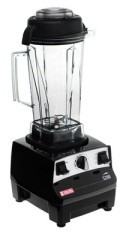 Good being the operative word here; there are a lot of choices for blenders on the market. Oster seems to dominate the affordable, home standby. But, unless you like that renegade hunk of ice in your Margarita. You might be happier with a little more power. So, lets talk price. Kitchen Aid and Cuisinart have always been depressingly horrible with more emphasis on design then performance. If you’re looking for a blender that does most jobs well, looks nice enough, lasts awhile and is around $150; go with an Oster or Waring.
Good being the operative word here; there are a lot of choices for blenders on the market. Oster seems to dominate the affordable, home standby. But, unless you like that renegade hunk of ice in your Margarita. You might be happier with a little more power. So, lets talk price. Kitchen Aid and Cuisinart have always been depressingly horrible with more emphasis on design then performance. If you’re looking for a blender that does most jobs well, looks nice enough, lasts awhile and is around $150; go with an Oster or Waring.
If you decide that versatility, power, overall performance, ease of use, ease of cleaning and longevity are important factors in your decision,; then the short list gets even shorter. Power wise, Blendtec makes a quality product but I don’t like using push button controls and the container is a little small. I like my blender to have an on/off switch, a hi/low switch and a separate full range speed dial. This makes ramping up hot liquids safer and easier.
Long story getting shorter…suck it up, spend the extra cash and get a Vita-mix with a speed regulating dial. You’ll never ask for anything more and you can successfully puree a friggin’ brick or, just use it for nut butters, veggies, ice drinks, and a multitude of emulsification’s. It can pulverize so efficiently that you can extract vital nutrients from produce (like a juicer), that other blenders can’t get near. Did I mention you don’t take it apart to clean? A little soap and water, a couple seconds on high and give it a rinse. $ = ![]()
4. Pots ‘N Pans
Thin pans will burn your food, so thick and heavy is always better. Having a non-stick pan is convenient for eggs and pancakes, but they are toxic and get worse with age. Unless that nonstick pan is a cast iron. I enjoy cooking with cast iron. Heats nicely, retains heat well, has an almost nonstick surface and is durable. More features are they are long lasting, clean easily, goes into a hot oven and are ridiculously inexpensive. They also look cool…not pretty, but cool. Downsides are, it’s heavy, rusts without proper care, and takes an extra minute to heat up. Not a bad ratio of positive to negative.
Let’s look at the other end of the spectrum with All Clad. It’s beautiful and shiny, heats evenly, transfers heat well, comes in complete sets and can go in the oven. Downsides are, it’s ridiculously expensive, handles are unsafe (the pan will rotate in your hand when full), and they get oil stained easily, thereby losing the beautiful quality.
Bottom line, I don’t care what you buy, but dropping 1-3 grand on some pot and pans will not make your food better. So what to get? Instead of recommending any set or brand, let me just give you a few basics.
You need:
A large stainless steel stock pot
1 large stainless steel sauté pan for searing and caramelizing (high sided is more versatile but not essential) A large non-stick sauté pan for things like eggs and pancakes
1 medium stainless steel sauté pot
So that is 4 essential pans and it could be three if your large saute pan is seasoned cast iron.
5. Outdoor grill
I know I know, this isn’t “in” most of our kitchens…semantics.
Obtaining “grill flavor” is so key in widening the variety of cultures and flavors we cook with. Whether gas or charcoal, grilling provides smokiness that cannot be achieved indoors. Fat melts, hits a flame, smokes, and that smoke flavors the meat. This is why charcoal usually tastes better; the fat hits the burning wood, not gas or hot metal. But don’t fret over which to buy, just get gas, it’s easy, clean and consistent. I use mostly gas but prefer the taste of charcoal. Also, many grills come with a nice size side burner which would kill that second bird you might be throwing stones at, (see tool #6). Shop around and look at multiple grills to match your needs but here are some buying tips.
First tip, one word…Weber. Second tip, wait for it…Weber. I’m not trying to get Weber to monopolize the market, but decade after decade they do what’s right, and Home Depot conveniently carries the replacement parts. Things like igniters,diffusers and grates. You might think; “why do they need all those replacement parts, if its so solidly built?” The ugly truth is, all gas grills will go bad at some point, especially if they aren’t covered or are never cleaned. Extreme expansion and contraction of the metal parts combined with moisture and time is not good for anything that isn’t totally sealed. Not having to rely on specialty stores or the internet for replacement parts makes life a little easier. 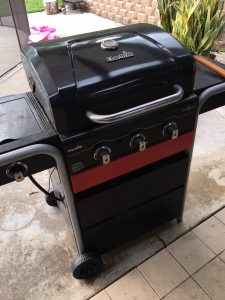
Grills should be somewhat heavy and simply designed. I like the flames to run up and down not side to side. That makes it easy to cook on only one side of the grill. Which is nice when you want to smoke something. Another big factor is the thickness of the grill grates. The thicker the better; iron is better than steel, and ceramic coated iron is nice and lasts a long time. I like iron and ceramic coated iron over the steal because they don’t let food stick as much and they heat up more evenly than steel.
If you’re looking to create authentic flavors of the Mediterranean, North and South America and India, then get yerself a good grill. Grilling also means less pans to wash…gigitty.
6. One powerful (Gas) burner
Simple and obvious, I think. But it can make the difference between an impressive meal and a Tuesday night dinner. There are times in cooking when high heat needs to be achieved and most importantly, maintained. Searing steak or fish and having fun with stir-fry’s demands high heat. As does boiling a large pot of liquid. Electric can get hot enough, but can be hard to control, and the pan cannot lose contact with the element.
We would all like a bad mammer jammer Wolf range, but the fact is, we all can’t. So, what to do?
If you happen to be in the market for a new stove, look for one with a burner that is obviously bigger than the rest. If you already have a stove in place and a new one is nowhere on the horizon, you have one solid option. Clean burning, natural propane (Hank Hill voice).
You can spend $40-$150 on single, double or triple propane burner. These options will get your pans or fry pots as hot as you need, (like a turkey fryer). You’ll need to have it stationed outside just like your grill, but that’s okay. You don’t want smoke or oil steam smelling up your house as it is. I get annoyed frying indoors, it always funks up the house, unless you have a better than average vent hood.
7. Spatulas,  (silicone and metal)-Everyone has a spatula, but not necessarily of the silicone variety. Hugely important, it’s one of those “go to” tools you’ll grab for anything requiring stirring, scraping or flipping. It’s great to have silicone because of its resistance to heat and its malleable nature. Perfect for getting corners that metal and wood cannot. The silicone is also safe for your non-stick pans. Growing up, our spatulas and pancake flippers were always plastic; and always melted. If you still have plastic tools in your drawers, toss em’ and get silicone.
(silicone and metal)-Everyone has a spatula, but not necessarily of the silicone variety. Hugely important, it’s one of those “go to” tools you’ll grab for anything requiring stirring, scraping or flipping. It’s great to have silicone because of its resistance to heat and its malleable nature. Perfect for getting corners that metal and wood cannot. The silicone is also safe for your non-stick pans. Growing up, our spatulas and pancake flippers were always plastic; and always melted. If you still have plastic tools in your drawers, toss em’ and get silicone.
Fish spatulas or thin metal pancake flippers are different but still use the word spatula. I can’t emphasize the importance of having something uber thin, yet rigid enough to flip stubborn items. Things that are delicate and like to stick to the pan, like eggs or a smash burger.
A fish spatula acts as a pancake flipper but is as thin and strong as you need to scrape the most stubborn egg or crispy browned potato. Not a common American kitchen tool yet, but it should be. If you don’t actually have a fish spatula, make sure you have a flat, thin metal flipper of some kind. It’ll save many a brown crust from staying on the pan and countess sponges from being over worked.
8. Metal Whisk
Did this need it’s own spot on the list? A whisk is a whisk…right?
If you’ve seen as many home kitchens as I have, you’d see why it’s on the list. Waaaaaay to many people have substandard whisks. If you enjoy cooking and baking, this thing is a work horse. From making aioli or vinaigrette, getting lumps out of a roux thickened sauce or whipping batters and eggs. Old school and standard are best. Ballooned at the end is preferable but the thinner models work well enough as a stand in. The ones that look like a spring are lame and plastic or silicone don’t provide enough rigidity. Whisks that look like elongated martini strainers are just useless. Same goes with the unconnected ball capped tines that look more like a flower stamen or a Cylon sex toy then a usable whisk. However, it will look nice in your tool bucket next to your stove.
9. Aluminum foil
Nothing beats classic Reynolds, but make sure you get the heavy duty kind. Foil is amazing and can be used to steam, roast, line a pan for easy clean up, or wrap something to grill. Speaking of grill, don’t have a grill brush? Wad up some foil and go to town. I can’t tell you how many times I’ve used it as a makeshift lid for a pot, or a makeshift anything. If I wasn’t married, here is how I might enjoy a bachelor’s dinner. Cover a pan in foil, roast some potatoes, transfer foil with potatoes to plate, add ketchup, eat, wrap up leftovers in same foil, no dishes…gigitty.
10. Openers (Can and Wine)
This might seem out of place and a little obvious, but what good is wine and can goods if you can’t open them? There are no other means to open these products and they are essential to kitchens everywhere. Wine is prevalent in 50% of my recipes and we all use canned goods. Whether it be coconut milk, black beans or pumpkin, we need both of these one trick ponies.
So that’s it! Sure you can fill your drawers with tools from across the globe or late night television. But you only need 10 to be a great cook. Now no more excuses ![]()
